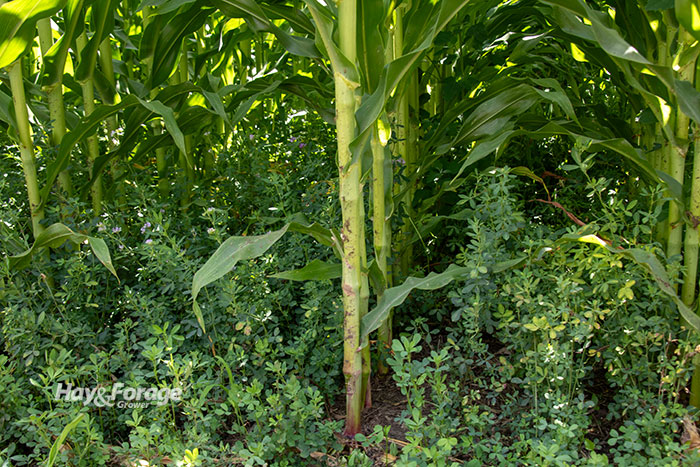
Interseeding alfalfa into corn for silage has been shown to improve first-year alfalfa yields, reduce soil erosion, and enhance a forage system’s overall profitability compared to seeding alfalfa in the spring. That isn’t to say there aren’t challenges associated with this practice or management strategies to consider.
The pros and cons of this type of establishment were recently discussed at the University of Wisconsin’s annual Agronomy and Soils Field Day at the Arlington Agricultural Research Station in Arlington, Wis.
John Grabber, a USDA-ARS research scientist with the Dairy Forage Research Center in Madison, Wis., has been studying alfalfa interseeded into corn silage for nearly 14 years. At the field day, he discussed what he has found to be the keys to this approach, as well as the agronomic and environmental factors that can interfere with crop performance.
Interseeding instructions
First and foremost, Grabber recommended choosing a site with soil properties, fertility, and pH levels that are conducive for alfalfa. He noted this is more important than utilizing a field that is better suited for corn silage. Likewise, the seedbed must be prepared with alfalfa in mind.
“In this system, we need to prioritize getting a good stand of alfalfa established,” Grabber said. “You are really using corn as a companion crop.”
Select an early to mid-season corn hybrid that can be harvested by early September. Then, plant corn at moderate populations of 26,000 to 32,000 plants per acre to reduce competition with alfalfa. The latter crop can be drilled between corn rows immediately after corn planting or shortly after corn germination. Grabber suggested seeding alfalfa at 16 pounds per acre and drilling seeds 1/4- to 1/2-inch deep.
Fertilize both crops according to corn’s nutrient needs, if not at slightly higher rates. Grabber said applying extra nitrogen might be advantageous since young alfalfa plants tend to take up this nutrient from the soil until they begin fixing it for themselves. Pre- and postemergence herbicides will enhance the interseeded system, and using a plant growth regulator like prohexadione on alfalfa when it is 4 to 12 inches tall can also boost root growth and promote better plant survival under corn once the canopy closes.
Grabber advocated for applying fungicide in all situations and coupling it with insecticide if necessary. “When corn is about 3 to 5 feet tall, we recommend applying a fungicide, and if there are potato leafhoppers or other pests, both fungicide and insecticide applications can be made,” he stated. “We recommend this be done every year, whether it is a dry year or a wet year.”
Some challenges
Rainfall, or the lack thereof, can have implications on more than just foliar diseases that warrant fungicide applications. For example, Grabber advised against interseeding alfalfa into corn silage if growing conditions are too dry.
“If it is really dry in the spring, you probably just want to plant one crop or the other,” he said. “If you plant both and there is no rain, alfalfa will take up the soil moisture. It will grow well, but corn yields will suffer.”
On the other hand, wet conditions during corn silage harvest can cause major rutting in the field, damaging alfalfa and making the stand less navigable for future harvests.
One of Grabber’s last points during his field day presentation was that different alfalfa varieties vary in their performance under corn silage. Before implementing this establishment system, consider the planning and inputs required to make it a successful endeavor.

